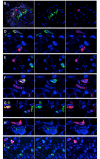A multicellular way of life for a multipartite virus
- PMID: 30857590
- PMCID: PMC6414197
- DOI: 10.7554/eLife.43599
A multicellular way of life for a multipartite virus
Abstract
A founding paradigm in virology is that the spatial unit of the viral replication cycle is an individual cell. Multipartite viruses have a segmented genome where each segment is encapsidated separately. In this situation the viral genome is not recapitulated in a single virus particle but in the viral population. How multipartite viruses manage to efficiently infect individual cells with all segments, thus with the whole genome information, is a long-standing but perhaps deceptive mystery. By localizing and quantifying the genome segments of a nanovirus in host plant tissues we show that they rarely co-occur within individual cells. We further demonstrate that distinct segments accumulate independently in different cells and that the viral system is functional through complementation across cells. Our observation deviates from the classical conceptual framework in virology and opens an alternative possibility (at least for nanoviruses) where the infection can operate at a level above the individual cell level, defining a viral multicellular way of life.
Keywords: evolution; genome; infectious disease; microbiology; multipartite virus; plant; population genetics; virus; virus-host interaction.
© 2019, Sicard et al.
Conflict of interest statement
AS, EP, RG, MV, MY, CU, MP, SG, YM, SB No competing interests declared
Figures








Similar articles
-
Replication-independent change in the frequencies of distinct genome segments of a multipartite virus during its transit within aphid vectors.Microbiol Spectr. 2024 May 2;12(5):e0028724. doi: 10.1128/spectrum.00287-24. Epub 2024 Mar 22. Microbiol Spectr. 2024. PMID: 38517168 Free PMC article.
-
Small Bottleneck Size in a Highly Multipartite Virus during a Complete Infection Cycle.J Virol. 2018 Jun 29;92(14):e00139-18. doi: 10.1128/JVI.00139-18. Print 2018 Jul 15. J Virol. 2018. PMID: 29720515 Free PMC article.
-
Effects of an Alphasatellite on the Life Cycle of the Nanovirus Faba Bean Necrotic Yellows Virus.J Virol. 2022 Feb 9;96(3):e0138821. doi: 10.1128/JVI.01388-21. Epub 2021 Nov 24. J Virol. 2022. PMID: 34818072 Free PMC article.
-
Nanoviruses: genome organisation and protein function.Vet Microbiol. 2004 Feb 4;98(2):103-9. doi: 10.1016/j.vetmic.2003.10.015. Vet Microbiol. 2004. PMID: 14741122 Review.
-
The Curious Strategy of Multipartite Viruses.Annu Rev Virol. 2020 Sep 29;7(1):203-218. doi: 10.1146/annurev-virology-010220-063346. Annu Rev Virol. 2020. PMID: 32991271 Review.
Cited by
-
Cellular and Natural Viral Engineering in Cognition-Based Evolution.Commun Integr Biol. 2023 May 2;16(1):2196145. doi: 10.1080/19420889.2023.2196145. eCollection 2023. Commun Integr Biol. 2023. PMID: 37153718 Free PMC article. Review.
-
Alfalfa leaf curl virus is efficiently acquired by its aphid vector Aphis craccivora but inefficiently transmitted.J Gen Virol. 2021 Feb;102(2):001516. doi: 10.1099/jgv.0.001516. J Gen Virol. 2021. PMID: 33210990 Free PMC article.
-
Incomplete bunyavirus particles can cooperatively support virus infection and spread.PLoS Biol. 2022 Nov 15;20(11):e3001870. doi: 10.1371/journal.pbio.3001870. eCollection 2022 Nov. PLoS Biol. 2022. PMID: 36378688 Free PMC article.
-
Genome segment ratios change during whitefly transmission of two bipartite cassava mosaic begomoviruses.Sci Rep. 2023 Jun 21;13(1):10059. doi: 10.1038/s41598-023-37278-8. Sci Rep. 2023. PMID: 37344614 Free PMC article.
-
Aspects of the lifestyle of multipartite viruses apply to monopartite segmented and perhaps nonsegmented viruses.Npj Viruses. 2024 Jul 25;2(1):31. doi: 10.1038/s44298-024-00045-1. Npj Viruses. 2024. PMID: 40295805 Free PMC article. Review.
References
-
- Brakke MK, Black LM, Wyckoff RWG. The sedimentation rate of potato yellow-dwarf virus. American Journal of Botany. 1951;38:332–342. doi: 10.1002/j.1537-2197.1951.tb14832.x. - DOI
Publication types
MeSH terms
Substances
Associated data
Grants and funding
LinkOut - more resources
Full Text Sources
Other Literature Sources

